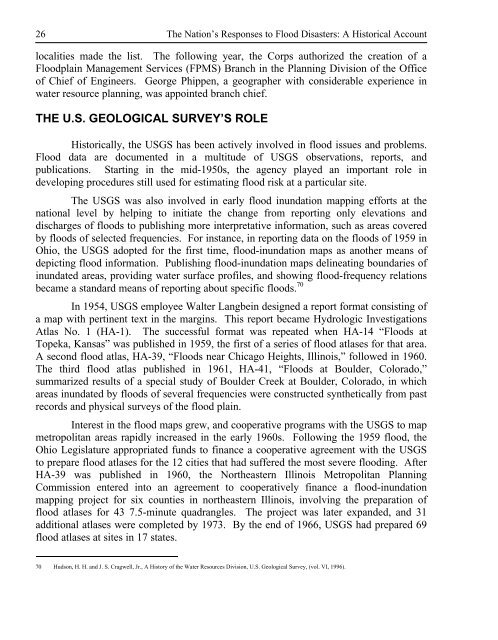The Nation's Responses To Flood Disasters: A Historical Account
The Nation's Responses To Flood Disasters: A Historical Account
The Nation's Responses To Flood Disasters: A Historical Account
You also want an ePaper? Increase the reach of your titles
YUMPU automatically turns print PDFs into web optimized ePapers that Google loves.
26<br />
<strong>The</strong> Nation’s <strong>Responses</strong> to <strong>Flood</strong> <strong>Disasters</strong>: A <strong>Historical</strong> <strong>Account</strong><br />
localities made the list. <strong>The</strong> following year, the Corps authorized the creation of a<br />
<strong>Flood</strong>plain Management Services (FPMS) Branch in the Planning Division of the Office<br />
of Chief of Engineers. George Phippen, a geographer with considerable experience in<br />
water resource planning, was appointed branch chief.<br />
THE U.S. GEOLOGICAL SURVEY’S ROLE<br />
<strong>Historical</strong>ly, the USGS has been actively involved in flood issues and problems.<br />
<strong>Flood</strong> data are documented in a multitude of USGS observations, reports, and<br />
publications. Starting in the mid-1950s, the agency played an important role in<br />
developing procedures still used for estimating flood risk at a particular site.<br />
<strong>The</strong> USGS was also involved in early flood inundation mapping efforts at the<br />
national level by helping to initiate the change from reporting only elevations and<br />
discharges of floods to publishing more interpretative information, such as areas covered<br />
by floods of selected frequencies. For instance, in reporting data on the floods of 1959 in<br />
Ohio, the USGS adopted for the first time, flood-inundation maps as another means of<br />
depicting flood information. Publishing flood-inundation maps delineating boundaries of<br />
inundated areas, providing water surface profiles, and showing flood-frequency relations<br />
became a standard means of reporting about specific floods. 70<br />
In 1954, USGS employee Walter Langbein designed a report format consisting of<br />
a map with pertinent text in the margins. This report became Hydrologic Investigations<br />
Atlas No. 1 (HA-1). <strong>The</strong> successful format was repeated when HA-14 “<strong>Flood</strong>s at<br />
<strong>To</strong>peka, Kansas” was published in 1959, the first of a series of flood atlases for that area.<br />
A second flood atlas, HA-39, “<strong>Flood</strong>s near Chicago Heights, Illinois,” followed in 1960.<br />
<strong>The</strong> third flood atlas published in 1961, HA-41, “<strong>Flood</strong>s at Boulder, Colorado,”<br />
summarized results of a special study of Boulder Creek at Boulder, Colorado, in which<br />
areas inundated by floods of several frequencies were constructed synthetically from past<br />
records and physical surveys of the flood plain.<br />
Interest in the flood maps grew, and cooperative programs with the USGS to map<br />
metropolitan areas rapidly increased in the early 1960s. Following the 1959 flood, the<br />
Ohio Legislature appropriated funds to finance a cooperative agreement with the USGS<br />
to prepare flood atlases for the 12 cities that had suffered the most severe flooding. After<br />
HA-39 was published in 1960, the Northeastern Illinois Metropolitan Planning<br />
Commission entered into an agreement to cooperatively finance a flood-inundation<br />
mapping project for six counties in northeastern Illinois, involving the preparation of<br />
flood atlases for 43 7.5-minute quadrangles. <strong>The</strong> project was later expanded, and 31<br />
additional atlases were completed by 1973. By the end of 1966, USGS had prepared 69<br />
flood atlases at sites in 17 states.<br />
70 Hudson, H. H. and J. S. Cragwell, Jr., A History of the Water Resources Division, U.S. Geological Survey, (vol. VI, 1996).
















